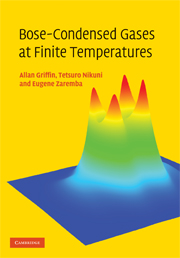Book contents
- Frontmatter
- Contents
- Preface
- 1 Overview and introduction
- 2 Condensate dynamics at T = 0
- 3 Coupled equations for the condensate and thermal cloud
- 4 Green's functions and self-energy approximations
- 5 The Beliaev and the time-dependent HFB approximations
- 6 Kadanoff–Baym derivation of the ZNG equations
- 7 Kinetic equation for Bogoliubov thermal excitations
- 8 Static thermal cloud approximation
- 9 Vortices and vortex lattices at finite temperatures
- 10 Dynamics at finite temperatures using the moment method
- 11 Numerical simulation of the ZNG equations
- 12 Simulation of collective modes at finite temperature
- 13 Landau damping in trapped Bose-condensed gases
- 14 Landau's theory of superfluidity
- 15 Two-fluid hydrodynamics in a dilute Bose gas
- 16 Variational formulation of the Landau two-fluid equations
- 17 The Landau–Khalatnikov two-fluid equations
- 18 Transport coefficients and relaxation times
- 19 General theory of damping of hydrodynamic modes
- Appendix A Monte Carlo calculation of collision rates
- Appendix B Evaluation of transport coefficients: technical details
- Appendix C Frequency-dependent transport coefficients
- Appendix D Derivation of hydrodynamic damping formula
- References
- Index
19 - General theory of damping of hydrodynamic modes
Published online by Cambridge University Press: 06 October 2009
- Frontmatter
- Contents
- Preface
- 1 Overview and introduction
- 2 Condensate dynamics at T = 0
- 3 Coupled equations for the condensate and thermal cloud
- 4 Green's functions and self-energy approximations
- 5 The Beliaev and the time-dependent HFB approximations
- 6 Kadanoff–Baym derivation of the ZNG equations
- 7 Kinetic equation for Bogoliubov thermal excitations
- 8 Static thermal cloud approximation
- 9 Vortices and vortex lattices at finite temperatures
- 10 Dynamics at finite temperatures using the moment method
- 11 Numerical simulation of the ZNG equations
- 12 Simulation of collective modes at finite temperature
- 13 Landau damping in trapped Bose-condensed gases
- 14 Landau's theory of superfluidity
- 15 Two-fluid hydrodynamics in a dilute Bose gas
- 16 Variational formulation of the Landau two-fluid equations
- 17 The Landau–Khalatnikov two-fluid equations
- 18 Transport coefficients and relaxation times
- 19 General theory of damping of hydrodynamic modes
- Appendix A Monte Carlo calculation of collision rates
- Appendix B Evaluation of transport coefficients: technical details
- Appendix C Frequency-dependent transport coefficients
- Appendix D Derivation of hydrodynamic damping formula
- References
- Index
Summary
In Chapter 17, we derived the Landau–Khalatnikov two-fluid hydrodynamics which describes the collision-dominated region of a trapped Bose condensate interacting with a thermal cloud. In this chapter, we use these equations to discuss the damping of the hydrodynamic collective modes in a trapped Bose gas at finite temperatures. We derive variational expressions based on these equations for both the frequency and the damping of collective modes. This extends the analysis in Chapter 16 in which a variational approach was developed to calculate the hydrodynamic two-fluid oscillation frequencies in the non-dissipative limit. A novel feature of our treatment is the introduction of frequency-dependent transport coefficients, which produce a natural cutoff eliminating the collisionless region in the low-density tail of the thermal cloud. Our expression for the damping in trapped superfluid Bose gases is a natural generalization of the approach used by Landau and Lifshitz (1959) for uniform classical fluids. This chapter is mainly based on Nikuni and Griffin (2004).
In Chapters 15 and 17, we derived a closed set of two-fluid hydrodynamic equations for a trapped Bose-condensed gas starting from the simplified microscopic model describing the coupled dynamics of the condensate and noncondensate atoms given in Chapter 3. These hydrodynamic two-fluid equations include dissipative terms associated with the shear viscosity, the thermal conductivity and the four second viscosity coefficients. Explicit formulas for these transport coefficients were derived in Section 18.1. Our goal in this chapter is to find a general expression for the damping of the two-fluid modes in terms of these transport coefficients. We emphasize that the damping of hydrodynamic two-fluid oscillations is completely different in nature from the Landau and Beliaev damping of oscillations in the collisionless region which is treated in Chapters 12 and 13.
- Type
- Chapter
- Information
- Bose-Condensed Gases at Finite Temperatures , pp. 414 - 430Publisher: Cambridge University PressPrint publication year: 2009



